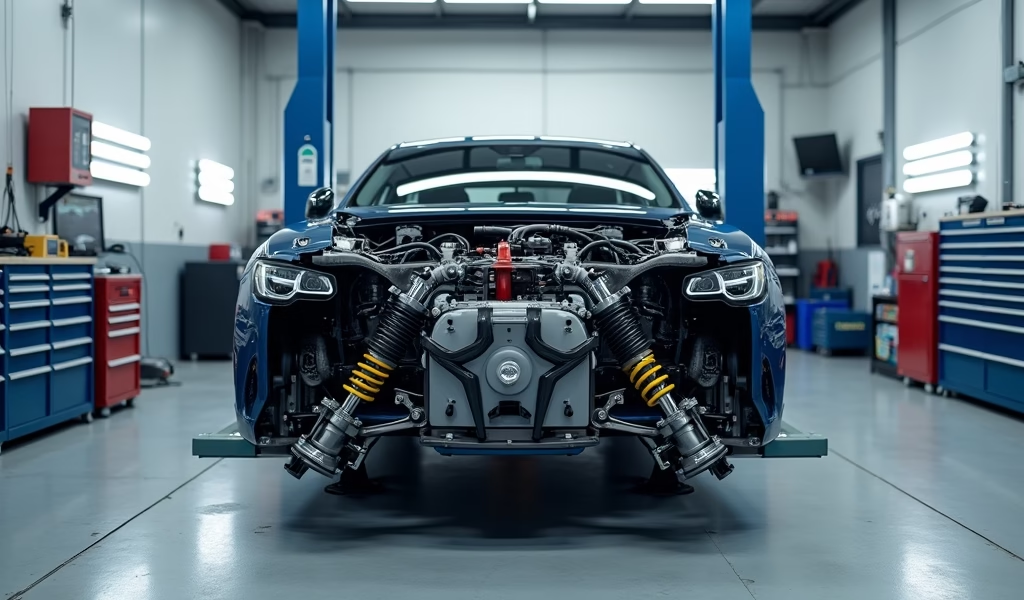Overview
This article provides a complete guide to electronic damping control systems in vehicles, covering how they work, common failure symptoms, diagnostic approaches, and repair options ranging from DIY troubleshooting to professional replacement. It emphasizes the importance of proper diagnosis before attempting repairs and explains cost considerations for different repair strategies, with prices ranging from $300 for component-level repairs to $3,000 for dealer replacement modules.
Table of Contents
- Understanding Electronic Damping Control
- How Electronic Damping Control Works
- Common Symptoms of EDC Failure
- Diagnosing EDC Module Issues
- DIY Troubleshooting Steps
- Professional Repair Options
- Replacement vs. Repair: Making the Right Choice
- Preventing Future EDC Module Failures
- Cost Considerations
- Conclusion
- Frequently Asked Questions
Understanding Electronic Damping Control
The electronic damping control module is the brain behind your vehicle’s adaptive suspension system, constantly adjusting how your car handles bumps and corners. Unlike traditional fixed suspensions, this smart system changes dampening force on the fly based on road conditions, driving style, and even your selected comfort mode. Think of it as having multiple suspension setups in one vehicle – from cloud-soft for highway cruising to track-firm for spirited driving.
Most modern luxury and performance vehicles come equipped with some version of electronic damping control. BMW calls it Dynamic Damper Control, Mercedes uses Airmatic, and Audi has their Adaptive Air Suspension. While brand names differ, the underlying technology remains similar across manufacturers.
When functioning properly, this system delivers the holy grail of ride quality: comfort when you want it and performance when you need it. But like any sophisticated electronic component, the electronic damping control module can develop issues over time. Understanding this system is your first step toward diagnosing and fixing problems when they arise.
How Electronic Damping Control Works
To appreciate how to fix electronic damping control problems, you first need to understand the system’s components and operation. At its core, the system consists of the central electronic damping control module, dampers with electronically controlled valves, various sensors monitoring vehicle movement, and the wiring connecting everything together.
The module receives input from multiple sources: acceleration sensors detect body movement, steering angle sensors track direction changes, and wheel speed sensors monitor road contact. Using sophisticated algorithms, the module processes this data up to 100 times per second to calculate optimal damping settings for each wheel independently.
When you hit a pothole, the system reacts almost instantly. The control module registers the impact through its sensors and sends commands to adjust the damper valves, changing how quickly oil flows through the shock absorber. This adjustment happens in milliseconds – faster than you can blink – adapting to changing road conditions before you even notice them.
The system also communicates with other vehicle modules through the CAN-BUS network. For example, it works with the roll stability control module to prevent excessive body lean during cornering, creating a coordinated response to driving dynamics. This integration explains why suspension issues sometimes trigger warning lights for seemingly unrelated systems.

Common Symptoms of EDC Failure
Recognizing the signs of electronic damping control failure early can save you from more extensive repairs down the road. The most obvious symptom is the illumination of the suspension warning light on your dashboard. This golden alert shaped like a car with wavy lines underneath means the system has detected a fault and requires attention.
Many drivers first notice something’s wrong when their once-smooth ride suddenly feels either excessively stiff or unusually bouncy. Your suspension might default to its firmest setting as a fail-safe measure, making every road imperfection feel like a major obstacle. Alternatively, you might experience a marshmallow-like ride with excessive body roll around corners.
Unusual noises provide another key indicator. Listen for knocking sounds when driving over bumps or a continuous compressor noise that doesn’t shut off. These acoustic warnings often suggest air suspension components are working overtime to compensate for electronic control issues.
Vehicle sagging presents a more visible symptom. If your car sits noticeably lower on one corner or droops overnight, the electronic damping control module might be failing to maintain proper ride height. This condition not only looks unsightly but can cause premature tire wear and handling problems.
Pay attention if comfort mode selections stop making any perceptible difference in ride quality. When the electronic controls fail, your sophisticated adaptive suspension effectively becomes a conventional fixed setup, negating one of the premium features you paid for when purchasing your vehicle.
Diagnosing EDC Module Issues
Proper diagnosis forms the cornerstone of effective electronic damping control module repair. Unlike mechanical problems that you can often spot with the naked eye, electronic issues require a methodical approach and the right diagnostic tools.
The first step involves connecting a quality OBD-II scanner capable of accessing suspension system codes. Basic code readers won’t cut it here – you’ll need one that can communicate with body control and suspension modules. Professional-grade scanners like Autel MaxiSys or Launch X431 offer the necessary capabilities, though quality consumer options like BlueDriver can sometimes access these systems too.
Once connected, look beyond the generic codes. Manufacturer-specific trouble codes provide the most accurate picture of what’s happening with your damping control system. Common codes include those related to communication failures, sensor malfunctions, or internal module errors.
After retrieving the codes, perform a thorough visual inspection of the system components. Check for damaged wires, corroded connections, or physical damage to sensors. Pay special attention to the wiring near moving suspension components, as these areas are prone to wear and chafing.
Advanced diagnosis might require monitoring live data parameters through your scanner while driving. Watching how the system responds (or fails to respond) to changing road conditions can reveal intermittent issues that static testing might miss. According to Underhood Service, checking voltage patterns during operation often reveals problems that won’t trigger traditional fault codes.
Remember that multiple systems interact with your electronic damping control. Issues with the stability control sensor alignment can sometimes create symptoms that mimic damping control problems. A comprehensive diagnosis considers these interconnections rather than viewing the suspension in isolation.
DIY Troubleshooting Steps
Before heading to a specialist, several DIY troubleshooting steps might resolve simpler electronic damping control issues. Start with the easiest fix: reset the system. Locate your vehicle’s suspension fuse in the fuse box (check your owner’s manual for the exact location), remove it for about 30 seconds, then reinstall it. This simple reset can sometimes clear temporary glitches in the electronic control system.
Next, inspect all accessible electrical connections related to the suspension system. Look for green corrosion on connector pins or damaged wiring insulation. Clean connections using electrical contact cleaner and a small brush, ensuring everything is dry before reconnecting. This basic maintenance step resolves a surprising number of intermittent electronic issues.
Check your vehicle’s battery health and charging system. Weak batteries or charging issues can create voltage fluctuations that play havoc with sensitive electronic modules. A multimeter reading below 12.6 volts (engine off) or 13.8-14.2 volts (engine running) suggests power problems that could affect your damping control module.
For the moderately skilled DIYer, testing individual suspension height sensors is possible with a multimeter. These sensors typically operate as variable resistors, changing resistance values as suspension height changes. Disconnect the sensor, then measure resistance while manually moving the suspension component it monitors. Readings should change smoothly through the range of motion.
If your vehicle uses air suspension alongside electronic damping control, listen for air leaks around the struts or air lines. A simple soapy water solution applied to connections will bubble if air is escaping. Small leaks can overwork the compressor and trigger fault codes in the electronic control system.

Professional Repair Options
When DIY troubleshooting reaches its limits, professional repair becomes necessary. You have several options, each with distinct advantages and considerations. The dealership service department offers manufacturer-trained technicians and genuine parts, but typically at premium prices. For vehicles still under warranty, this remains the safest option to avoid coverage complications.
Independent shops specializing in your vehicle’s make can provide comparable expertise at more competitive rates. Look for shops with ASE-certified technicians who have invested in the proper diagnostic equipment for sophisticated suspension systems. A good independent specialist stays current with manufacturer technical service bulletins that might address known electronic damping control issues.
Suspension specialists focus exclusively on ride control systems and often develop expertise beyond what general repair shops offer. These specialists frequently deal with electronic damping issues across multiple brands, giving them a broader perspective on common failure patterns and effective solutions. Research suggests shops with this focused experience often identify root causes more quickly than general repair facilities.
Module rebuilding services represent another option worth considering. Companies like Module Experts or ModuleMasters specialize in repairing the electronic control units rather than replacing them. This approach typically costs 50-70% less than new replacement modules while addressing the actual component failures within the unit.
When selecting a professional repair option, ask specific questions about their experience with your vehicle’s electronic damping system and their diagnostic approach. The best shops explain their process clearly and provide a detailed explanation of the problem before beginning expensive repairs.
Replacement vs. Repair: Making the Right Choice
When facing electronic damping control issues, you’ll inevitably confront the repair-versus-replace decision. New dealer modules typically cost between $800 and $2,000 depending on your vehicle make and model, plus programming and installation. While expensive, new modules come with warranties and eliminate any uncertainty about fixed components failing again.
Rebuilt or remanufactured modules offer a middle ground, usually costing 40-60% of new units while still addressing all known failure points. Quality rebuilders test units under load conditions that simulate real-world operation, often uncovering weaknesses that static testing might miss.
Component-level repair represents the most economical approach but requires specialized knowledge. Skilled electronics technicians can identify and replace failed capacitors, transistors, or other discrete components within the module. This approach works best for common failure patterns where specific components regularly fail across many units.
Consider your vehicle’s age and value when making this decision. For newer luxury vehicles worth $50,000+, factory replacement modules make financial sense. For older vehicles approaching the end of their service life, rebuilt options or even used modules (with appropriate caution) might be more appropriate.
Whatever option you choose, ensure proper programming follows installation. Modern electronic damping control modules require vehicle-specific coding and adaptation procedures. Skipping this critical step leads to poor performance even with perfect hardware.
Preventing Future EDC Module Failures
After investing in fixing your electronic damping control module, taking preventative measures helps avoid repeat failures. Start with addressing the module’s environment. Many electronic control units fail due to exposure to excessive heat, moisture, or vibration. If your module mounts in a splash-prone area, consider adding protective covers or relocating it to a drier location if possible.
Regular electrical system maintenance plays a crucial role in module longevity. Keep your battery in excellent condition and ensure your charging system operates within specifications. Voltage spikes from failing alternators or jump starts represent a leading cause of electronic module damage.
Pay attention to software updates for your vehicle’s control modules. Manufacturers occasionally release updates that improve system robustness or address known issues. These updates don’t always come with recalls or service bulletins, so asking your service facility to check for available updates during regular maintenance makes sense.
Don’t ignore early warning signs of suspension component wear. Mechanical failures in struts or shock absorber rebound adjustment mechanisms can place additional strain on the electronic control systems. According to AERA Engine Builders Association, premature electronic failures often follow unaddressed mechanical suspension issues.
Consider upgrading any aftermarket suspension components to those specifically designed to work with your electronic damping control system. Mismatched components can send conflicting information to the control module, potentially causing erratic operation or accelerated wear.
Cost Considerations
Understanding the financial aspects of electronic damping control repairs helps you budget appropriately. Diagnostic costs typically range from $100-$200 for comprehensive electronic testing. This expense proves worthwhile even if you ultimately perform repairs yourself, as proper diagnosis prevents the costly “parts cannon” approach of replacing components unnecessarily.
For module replacement, expect varying costs based on your repair path. Dealer new modules with installation typically run $1,000-$3,000 depending on vehicle make and complexity. Rebuilt modules installed at independent shops generally cost $600-$1,500, while component-level repairs might range from $300-$800.
Don’t forget about associated costs that often accompany module issues. Height sensors ($100-$250 each), air struts ($400-$1,000 each), and wiring repairs ($150-$300) frequently need attention alongside the main module. A complete system overhaul on a luxury vehicle can approach $5,000 when addressing all wear items simultaneously.
Extended warranty coverage merits consideration if your vehicle has sophisticated electronic suspension systems. While factory warranties typically cover these components for 4-6 years, specialized third-party coverage for electronic systems can provide valuable protection for higher-mileage vehicles. Just verify that electronic suspension components are specifically included in any policy you consider.
Finally, weigh repair costs against your vehicle’s current market value. Investing $2,500 in a comprehensive suspension electronics overhaul makes sense for a $60,000 vehicle you plan to keep long-term but might exceed reasonable budgeting for a $7,000 vehicle approaching end-of-life.
Conclusion
Successfully fixing electronic damping control module issues requires understanding the system, properly diagnosing problems, and selecting the appropriate repair approach. Whether you choose DIY troubleshooting, professional module replacement, or component-level repair, addressing these issues promptly preserves your vehicle’s ride quality and prevents cascading failures in related systems.
The complexity of modern adaptive suspension systems means there’s rarely a one-size-fits-all solution. Your vehicle’s specific design, age, and condition will guide the most effective and economical repair strategy. By combining the technical knowledge outlined in this guide with professional assistance when needed, you can restore your suspension to its factory-designed performance.
Remember that proper maintenance after repairs extends module life considerably. Addressing environmental factors, keeping electrical systems in top condition, and promptly fixing mechanical suspension components all contribute to electronic damping control longevity. With these practices in place, you can enjoy the superior ride quality these sophisticated systems provide for years to come.
Frequently Asked Questions
What exactly does an electronic damping control module do?
The electronic damping control module constantly adjusts your vehicle’s suspension stiffness based on road conditions and driving style. It processes data from various sensors to optimize ride comfort and handling in real-time.
How much does it cost to replace an electronic damping control module?
Replacement costs typically range from $800-$3,000 depending on your vehicle model and whether you choose new, rebuilt, or used parts. Labor costs add approximately $150-$300 for installation and programming.
Can I drive with a faulty electronic damping control module?
Yes, but your vehicle will likely default to a fixed suspension setting that may feel uncomfortably stiff or soft. Long-term driving with a faulty module can accelerate wear on other suspension components.
How long do electronic damping control modules typically last?
Most modules last 8-12 years under normal conditions. Environmental factors like extreme temperatures, moisture exposure, and electrical system issues can significantly reduce this lifespan.
Will a generic OBD2 scanner diagnose damping control module issues?
Most basic OBD2 scanners cannot access suspension-specific trouble codes. You’ll need a professional-grade scanner with body control module access or manufacturer-specific software for proper diagnosis.

